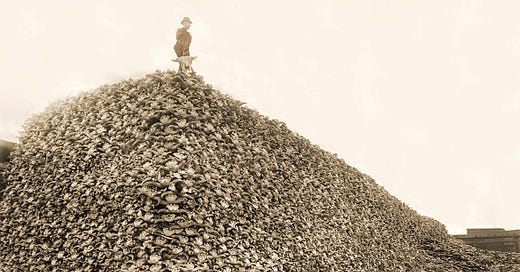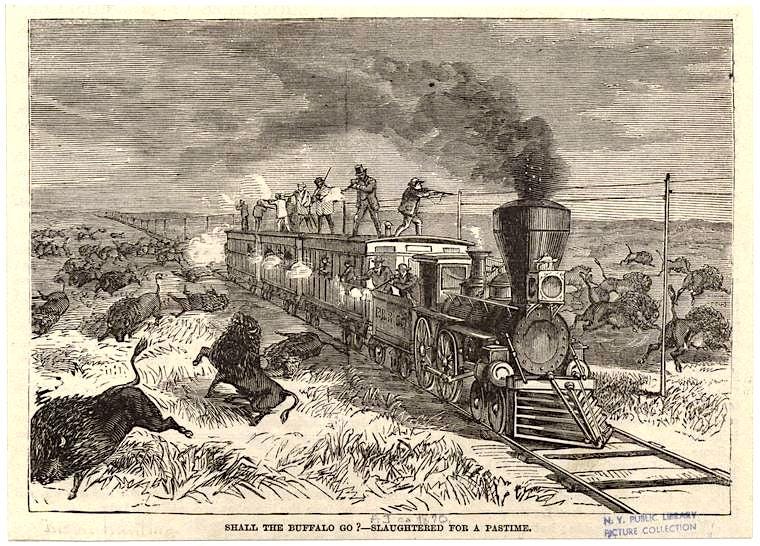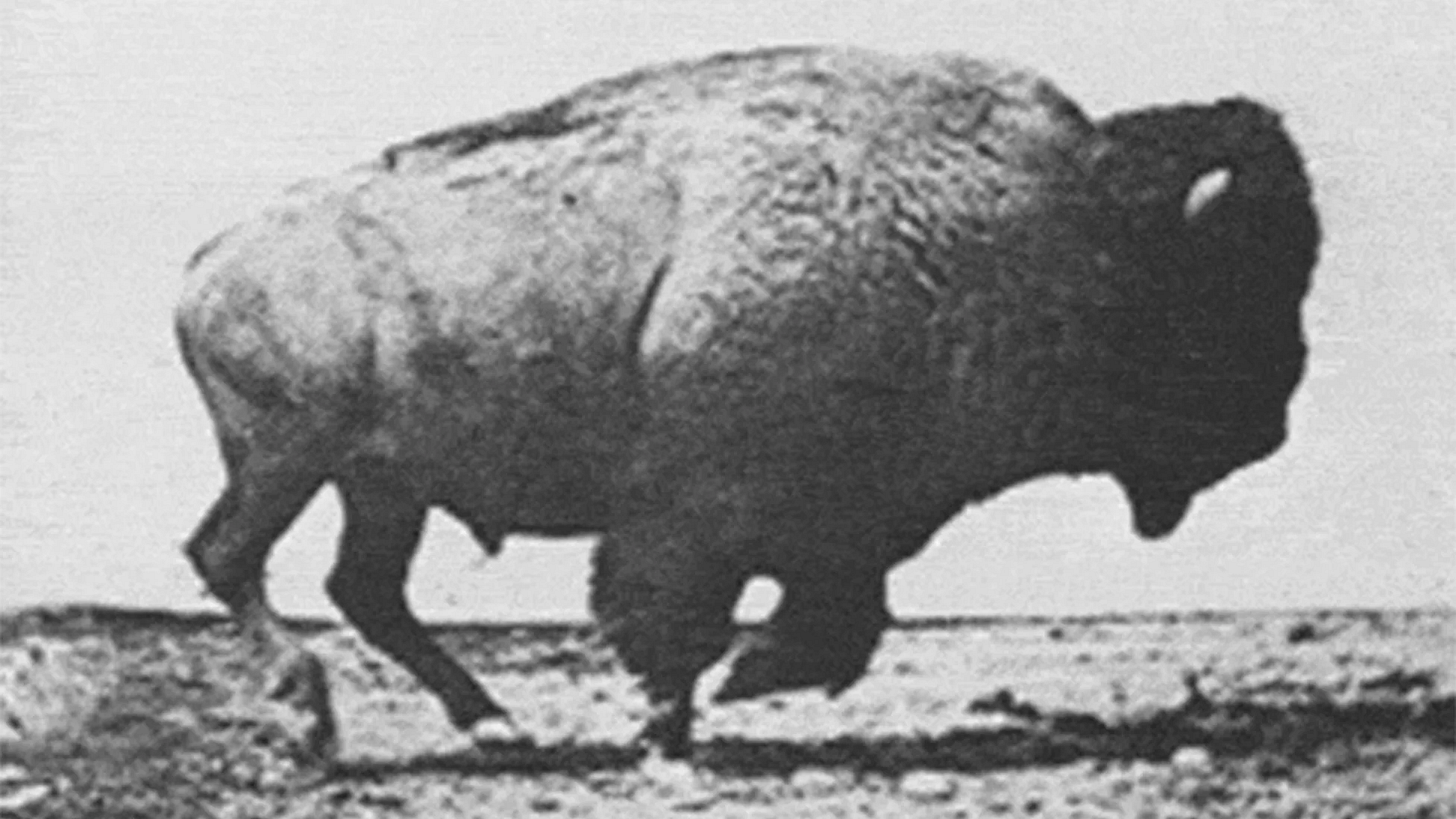American Genocide – Bison to Beef?
The tragedy of the American Bison (Tatanka) is one we should never allow again.
Centralized control of the American meat supply is the downfall of our ecological health and all Americans' food security.
To understand the vulnerabilities we currently face, we need only look back a few years.
“Three separate events in 2019, 2020 and 2021 highlighted the country's reliance on large beef plants run by the four biggest processors.
First, a large Tyson Foods plant in Holcomb, Kansas, closed for four months following a fire on Aug. 9, 2019, that reduced U.S. beef production [by 6%]1 and removed a market where farmers could sell their cattle.
The second disruption occurred as COVID-19 spread last year, causing slaughterhouses nationwide to close to contain outbreaks of the virus among workers.”2 (Reuters, June 17, 2021)
The third event occurred on Sunday, May 30, 2021. JBS USA, “which supplies more than a fifth of all beef in America, said all of its US beef plants were pushed offline” after a serious ransomware attack. This subsequently caused a dramatic surge in beef, veal and pork prices.3 (emphasis added, The Guardian, June 2, 2021)
How did we get here?
How did we go from Native people and pioneers who understood food security and food resilience to the vulnerabilities we face today?
In the natural system that existed for millennia on the American plains, tens of Millions of bison were integral to the ecosystem. Tatanka, Lakota word for bison, grazed the grasses of the prairie, causing disturbance and then resilience in the cycle of growth, and in the soil beneath. As they moved across the land–never staying in one place in their attempt to keep ahead of predators–they left behind their manure to fertilize the soil. In this natural cycle, whenever something was taken (grass and forage), something was left (manure, seed and urine).
Their manure created the rich, fertile soils of the American plains.
In this natural system, the birds traveled behind the bison, collecting insects, grasses, and the occasional seed. As they went, the birds deposited their nitrogen-rich manure, adding more to the soil.
For millennia, this ecosystem cycled, building the soil fertility unique to the American grasslands. We depend upon these soils today.
Native tribes called this vast land home and heavily relied on tatanka for food, clothing and shelter. It was paramount to the Native people’s survival.
In the 1860s, that all changed.
What happened to disrupt this?
Nothing illustrates the dark underside of the 19th century prevailing ideology like the mass slaughter of the American bison in the late 1800s.
Unscrupulous, profit-driven destroyers wanted to see the death of all Native people. And so commenced one of the greatest genocidal and ecological atrocities of all time–the mass killing of the American bison. The destruction of the bison was a means to an end–the end being the annihilation of the Native people.
“Deprive the red man of buffalo, and he cannot, during midwinter especially, carry on a successful raid. From the bison he obtains his provision, robes and covering.”4
In hindsight, it was fairly easy to kill off millions of American bison in the 1860-70s as they roamed free.
“Bison hunting intensified after the completion of the transcontinental railroad in 1869. Hunters arrived west in droves, many hoping to make fast money by killing the bison. Some of these "buffalo runners" even got their bullets from U.S. army commanders. By the 1870s, they were killing an average of 5,000 bison a day.”5
Their large bodies were easy targets for depraved “hunters” leaning out of the new trains snaking through the country. There was no sport to it, only blood lust fueled profit. No longer was there a reverence for the life of tatanka and the gifts that harvesting this majestic animal brought to the communities.
It took a very short time to destroy the Native’s way of life by eliminating their food source. “One colonel, [in 1867] told a wealthy hunter who felt a shiver of guilt after he shot 30 bulls in one trip: “Kill every buffalo you can! Every buffalo dead is an Indian gone.”6
It was reckless killing for the sake of destruction.
Will we ever be able to recover from the ecological abuse and the genocidal mentality that destruction left behind?
150 years later, we live in an era where 80% of our meat in America comes from only 4 companies.
Imagine for a moment if an enemy of the American people wanted to exterminate us or destroy our way of life. What would it take to starve the American people into compliance?
A modern extermination would not need the 20 year campaign of hired hunters chasing the bison across the plains.
Could a concerted flip of switches, cyber attacks, and/or sabotaged structures at major meat processing or packing institutions lead to similar results?
Could we, The People, muster enough resilience to recover from such an act?
Looking at the same topic from another angle, how can we rely on our food security when monopolized by 4 major for-profit corporations? What entities want to keep us separated from our food production and processing at a local level?
What happened since 1860 when the Native people knew what to eat and how to prepare it and the early American settlers knew how to raise and process animals for food? All with very little refrigeration, or none, it should be noted.
Somehow, all these families knew how to safely harvest, process, cook and eat their meat. And they passed this knowledge from generation to generation.
True food security only exists on the community level.
Decentralization of our meat production and processing is a vital element of a free society. If we are not able to feed ourselves, we will not be able to defend ourselves. Conversely, if we are not able to defend ourselves, we will not be able to feed ourselves.
It is the decentralization of the meat industry that will revitalize our American freedom.
While the magnificent American bison are most likely off our prairies forever, herds of cattle, sheep and goats–through healthy farming practices–can offer food security and food resilience to our communities.
But only if American small farmers are empowered to feed America on the community level through decentralized production and local, humane meat processing.
We must have this option!
Legislative initiatives such as the PRIME Act can open some of these doors. Localized production and processing of our meat is what will keep us safe–both in the short term–with food safety–and in the long term–with community food security and food resiliency.
As we return to the knowledge and wisdom of our ancestors, we must support and respect those who safeguard this knowledge for us–the farmers, ranchers and hunters of America and the men and women who reverently turn animals into food for our tables.








in the 70's i went to USA and visited bud basolos? buffalo farm where he crosses the buff and a cow. i think he had the largest preservation of buffs in usa at the time. always wondered what eventuated there?
A beautiful animal never forgotten after encountering one.
Thank You for the reminder.
New here, by way of Sally's Real Life (Sally Oh!)...bravo for this piece...right on~Wok-so-pa,Mikuye ! ( loosely translated as 'Make me Brave~and WISE!''~LAKOTA NATION